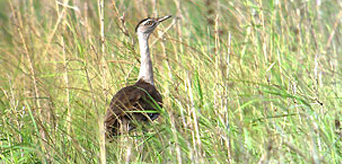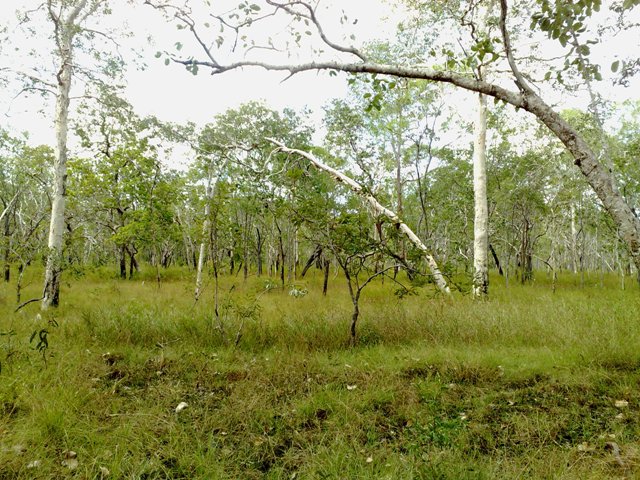Birding in Wasur National Park
Summary:
Extreme lowland birding in the swamp forests and savannahs of Papua’s far south. Absolutely overrun with birds including Trans-Fly specials and many Australian migrants.
Key bird species:
Southern Cassowary; Forest Bittern; Australian Ibis; Straw-necked Ibis; Royal Spoonbill; Black-necked Stork; Brolga; Australian Bustard; Magpie Goose; Whistling Kite; Swamp Harrier; New Guinea Flightless Rail; Southern Crowned-Pigeon; Little Corella; Palm Cockatoo; Yellow-streaked Lory; Red-flanked Lorikeet; Orange-breasted Fig-Parrot; Red-winged Parrot; Pheasant Coucal; Barking Owl; Southern Boobook; Marbled Frogmouth; Blue-winged Kookaburra; Spangled Kookaburra; Noisy Pitta; Tawny-breasted Honeyeater; White-throated Honeyeater; Little Friarbird; Brown-backed Honeyeater; Rufous-banded Honeyeater; Rufous Monarch; Black-faced Monarch; Leaden Flycatcher; Lemon-bellied Flycatcher; Grey Shrike-Thrush; Grey-crowned Babbler; Fly River Grassbird; Painted Quail-Thrush; Beccari’s Scrubwren; Fairy Gerygone; Green Oriole; Magpie-Lark; Australasian Magpie; Greater Bird-of-Paradise; Spotted Catbird; Fawn-breasted Bowerbird; Crimson Finch; White-spotted Munia; Black Munia; Grey-crowned Munia.
Birding locations:
Wasur National Park is a vast area of forest, swamp forest, savannah and wetland in the far south-east corner of Papua. It is bordered by the sea to the south and PNG to the east and is as far away as you can get from Jakarta while staying in Indonesia! It lies within the Trans-Fly region of New Guinea and both the habitat and birds have much in common with northern Australia only 200 km to the south. The site is very seasonal, with both a pronounced wet and dry season, and a pronounced bird migration season to match. The dry season starts from around late-June/July and runs for a few months. This is the time that Australian migrants peak also. Before July getting around in the interior of the park can be very difficult as vast areas become flooded. From June/July things start drying out and access becomes easier. By August/September the place is pretty dry and even the most remote corners of the park can be visited by trail bike or 4×4. The area is pretty unexplored by birders, so the following sites are by way of suggestions only, doubtless many other places are yet to be found.
- Ndalir
Ndalir is a village about an hours drive from Merauke along the coastal road. There is a good variety of habitat in a small area here which makes for a constant supply of birds. In front of Ndalir is a large expanse of tidal mudflat and sand that can hold large numbers of migrant waders and waterbirds. Directly behind Ndalir are areas of Mangrove, open ‘melaleuca’ or paper-bark forest, thickets of dense monsoon forest, open wetlands and reedbeds. Around the village and coastal road there are also areas of scrub and dry grassland. The forest areas can be very productive with mixed species flocks including Grey Shrike-Thrush; Grey-crowned Babbler, Black-faced and Rufous Monarch, Mangrove Fantail, Fairy Gerygone, Beccari’s Scrub-wren, and some of the regional honeyeaters such as White-throated, Rufous-banded and Brown-backed. The wetland area holds lots of waders, ibis and spoonbill, Black-necked Stork and can occasionally hold Magpie Geese and Rajah’s Shelduck. White-spotted Munia has been seen in the bamboo close to Ndalir.
- Yanggandur
Near this village in the centre of the park is some accessible monsoon forest areas. The access is about 1-2 hours drive from Merauke, then about a 3km walk or bike ride through open melaleuca forest. Once in the forest there is a large clearing with some huts that can be used as accommodation and lots of trails heading into more dense forest. Greater Bird-of-Paradise are found throughout this area, and can be seen from the main clearing. The clearing area is also good for parrots, including Black Cockatoo, Dusky Lory, Rainbow and Red-flanked Lorikeet and occasionally Little Corella.
A trail heads north from the clearing and passes through monsoon forest for around 2km. After this the trail continues across another 2km of open melaleuca forest before plunging once again into monsoon and swamp forest. The birding is great in these forest areas and specialities that can be found include Southern Cassowary, Southern Crowned-Pigeon (in the swamp forest area), Painted Quail-thrush, Noisy Pitta, Marbled Frogmouth, Forest Bittern, Spotted Catbird, Blue-winged and Spangled Kookaburra (at the forest edge).- Track to Mblatar
For those looking to see something of the vast swamps and savannahs of the interior of the park as trip along the coastal track as far as it will go is a good one. From Ndalir the road is in pretty good condition, but it progressively deteriorates into little more than a footpath by the time Mblatar is reached as its eastern-most extremity, little more than 10km from the PNG border. The drive takes around 6-7 hours and passes through both excellent condition monsoon and melaleuca forest and some vast short-grass savannah. At Mblatar itself the habitat is a mix of wetland pools and streams, savannah and melaleuca forest. Birds that can be seen either at Mblatar or on the way include Australian Ibis, Straw-necked Ibis, Royal Spoonbill, Black-necked Stork, Brolga, Australian Bustard, Magpie Goose, New Guinea Flightless Rail, Barking Owl, Southern Boobook, Magpie-Lark; Australasian Magpie and the Trans-Fly endemic savannah munias: Black, Grey-crowned and White-spotted.
Access, accommodation & timing:
Merauke can easily be reached by plane from Jayapura (Sentani Airport). The town of Merauke itself is quiet large and there are numerous cheap hotel and restaurant options.
To get at the birds the best bet is to report to the National Park office near the airport (Jalan Garuda Leproseri No. 3, Mopah Lama, Merauke, 99611, Papua, Indonesia; Tel: +62-971-325407; Email: info@wasur.com). All of the birding sites mentioned above lie within the park and so formal permission is required to visit them. The park is generally very accommodating of visitors and they can assist in hiring cars and finding local guides, porters, food as necessary. You will probably need to pay for at least one park guard to accompany you, but the advantage of this is that you can then use their accommodation at Ndalir. Its will also help you deal with the numerous police and army posts (this is a border area after all). You will also need a Surat Jalan, but the park can help you get this locally if you haven’t got one already. You will need to buy all the food you need in Merauke as there are no shops within the park, the food you buy will also need to be enough to cover your various guides and porters. Outside of Ndalir the accommodation is generally camping unless you can find an unoccupied hut, or get yourself invited into an occupied one! Outside of the dry season road access by car is very limited.Site Map:
To download the kml file click here


